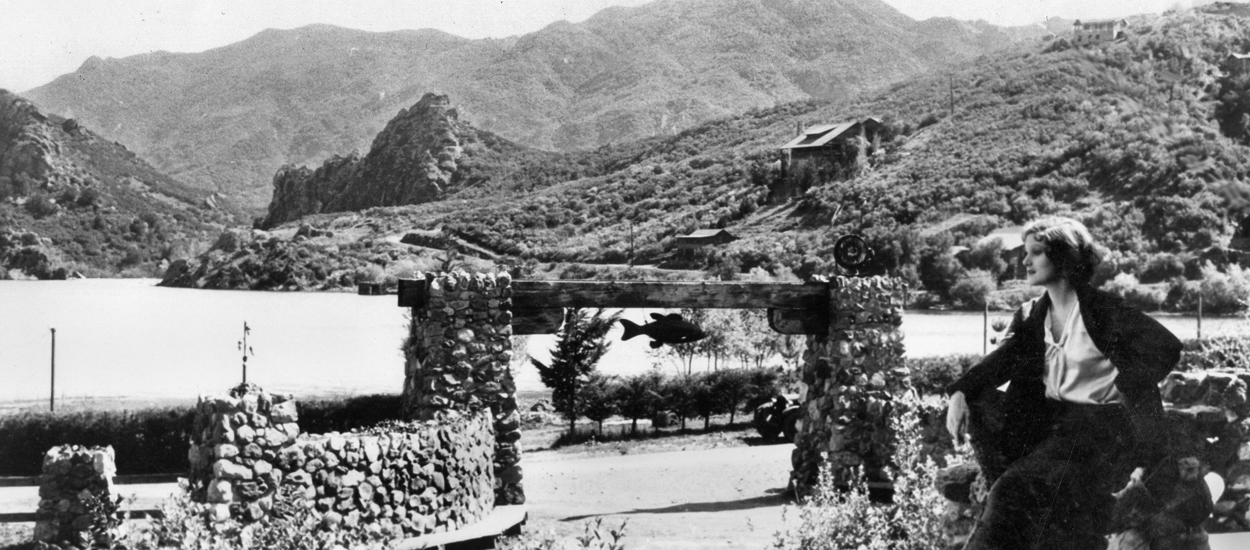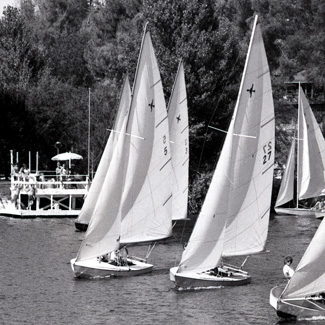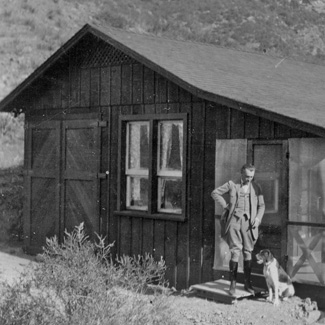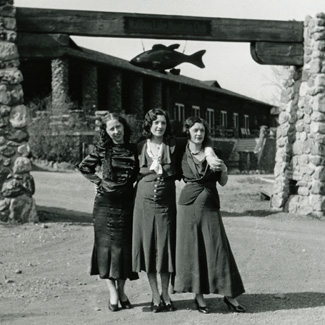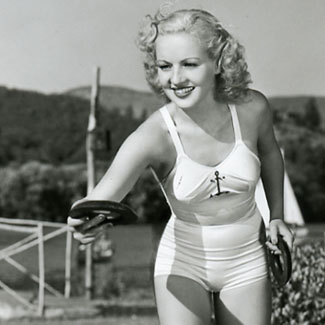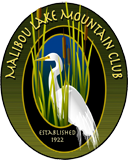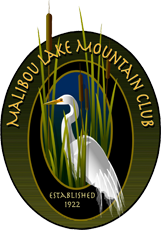In 1922, Club founders Bertram Lackey and George Wilson stood on a dirt road overlooking a dry flood plain in the Santa Monica Mountains - the confluence of Triunfo Creek and Medea Creek - and saw what others had not: a rural community of mountain cabins surrounding a beautiful lake.
Malibou Lake was a visionary endeavor.
Malibou Lake, c. 1933
The extension of Pacific Coast Highway as well as Mulholland Highway were still years away. The fastest route from downtown was through the San Fernando Valley taking about an hour and 45 minutes. It took 3 hours going through Santa Monica and Topanga. Lackey and Wilson had ventured south from the Conejo Valley on a dirt wagon route called Cornell Road off Santa Barbara-Ventura Road (now Agoura Road). They knew that with enough rain, the two creeks at their feet would engorge the floodplain and a body of water could result.
There were few roads in the mountains then.
was originally planned as a 352-acre fishing and equestrian preserve with weekend cabins for members. One of the major factors in choosing this location was the rocky pinchpoint where a dam could be legally permitted and built. The Club’s land was a combination of the southern end of the nearly 18,000 acre Rancho Las Virgenes, a Spanish grazing concession and government land settled under the Homestead Act. The property line that divides our club from the Malibu Lakeside community next door is the old southern border of the Rancho Las Virgenes. That simple, unassuming remnant of Spanish Colonial California remains at the lake today.
The Malibou Lake Country Club
for pleasure purposes, but there was little pleasure from what could only be called “Malibou Pond” as a spell of dry years kept the water level low. No one envied the real estate salesman pitching lake front cabins around a non-existent lake. While the work was completed in 1923, it took a late spring storm in 1926 to fill the lake for the first time. Club members threw a party that lasted for days.
The Malibou Lake Club was originally promoted
designed by the architectural and engineering firm of Russell & Alpaugh of Los Angeles, opened its doors to members. An enormous native stone fireplace, some 15 feet wide, highlighted the magnificent foyer and grand dining room. A large patio ran along the exterior of Redwood logs while a locker room and a billiard room provided a private refuge from the women! The old lodge included a chef’s kitchen and 24 bedrooms with separate baths for visitors, a trading post, stables, barbecue pit, baseball diamond, a fleet of rowboats, a swimming beach and changing areas. In September
1924, the membership of the Camp Fire Club of Los Angeles merged with Malibou Lake Country Club. This group included film industry notables Cecil B. DeMille, Thomas Ince, Douglas Fairbanks and Jesse Laskey. Samuel Rindge and Merritt Adamson of Rancho Malibu and noted businessmen from throughout the Los Angeles area including the Dohenys were also members. The club hosted tennis playoffs, quarterhorse races, baseball, archery, and trapshooting.
In May 1924, the Club's grand lodge
of the Malibou Lake Country Club joined forces and bought out Lackey and Wilson for approximately $250,000. By December 1926, the newly formed corporation of the Malibou Lake Mountain Club began operations. This dynamic has not changed since then as the majority of stockholders in this corporation are homeowners. Our club was based upon a grand tradition of social clubs and because of it’s convenient proximity to the city evolved into a residential club. We are a corporation disguised as a community. Or perhaps we are a community disguised as a corporation.
In the fall of 1926, 258 members
with a degree of invisibility. Members furthered that secrecy by removing highway signs that gave directions to the lake; hoping to hide it from tourists. The Club's log lodge burned to the ground in a 1936 fire but was replaced by another Russell & Alpaugh design, that gracious clubhouse still stands today. Built to serve a smaller membership than the previous building, the 1936 clubhouse features a ballroom with a fireplace that opens onto a large patio, a speakeasy poker room with a mural of original members, 18 inactive ensuite guest rooms, a swimming pool and tennis court.
Malibou Lake has long been blessed
was installed in May of 1953 at a gala dinner dance. The Reagans owned Yearling Row Ranch next to our lake and attended many club parties and had quite a few friends at the lake. These were dress-up formal affairs with dinner and music from full bands and orchestras. The following month the newsletter reported “His Honor, Ronald Reagan, Honorary Mayor of Malibou Lake, was a little late for dinner, because he was working, but we are all so happy to know a movie star who is working these days that we didn’t mind”. Bill Richter introduced him and said that when he first mentioned the honor, Ronnie wanted to know what the duties were. Bill told him we didn’t have any supermarkets to open or babies to be kissed, but we could use a little help with the plumbing! Ronnie displayed his good sportsmanship and accepted! He told us that his secret ambition has always been to be an Honorary Mayor. This was Reagan’s first political office. The electoral career of a future President of the United States began at Malibou Lake.
Our Honorary Mayor Ronald Reagan
“…a realization of his fireside dream, a spot where he may dwell in his own mountain cabin in the midst of all that the outdoors can give.” Malibou Lake remains out of earshot of the freeways and out of view of commuters, tracts of ranch homes and shopping malls. It is for many a secret spot of tranquility amidst the burgeoning population of Southern California.
Our co-founder Bertram Lackey saw Malibou Lake as
Co-founder Bertram Lackey outside his cabin
Members & friends outside the original lodge
Sailboat regatta, Malibu Class boats
MOVIE HISTORY
HISTORY
Read about
Club history
in our
85th anniversary
booklet
Explore our
fascinating area
in the best-
selling local history book
"Three
Magical Miles"
Cool merch celebrating
our Centennial
is still available
